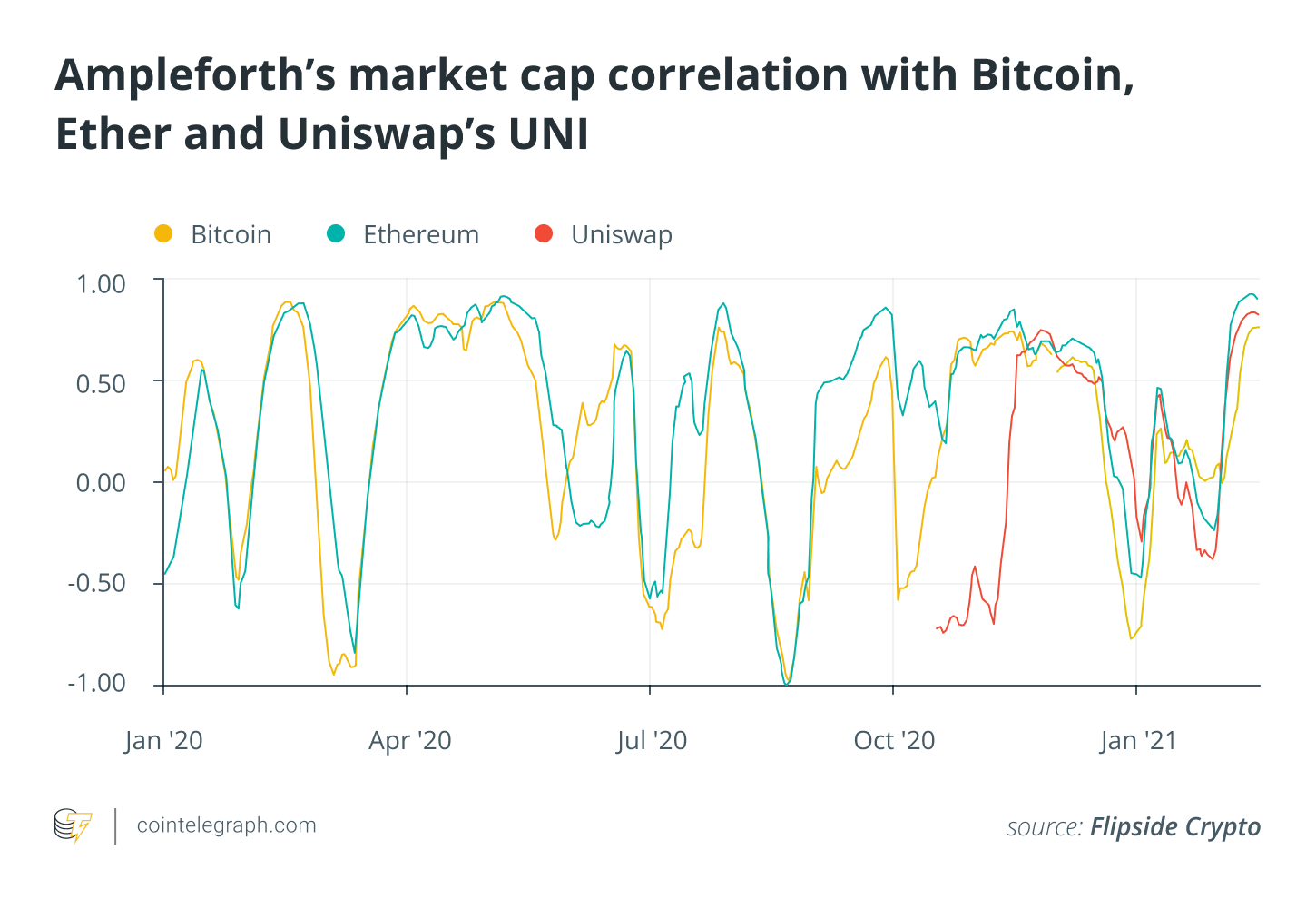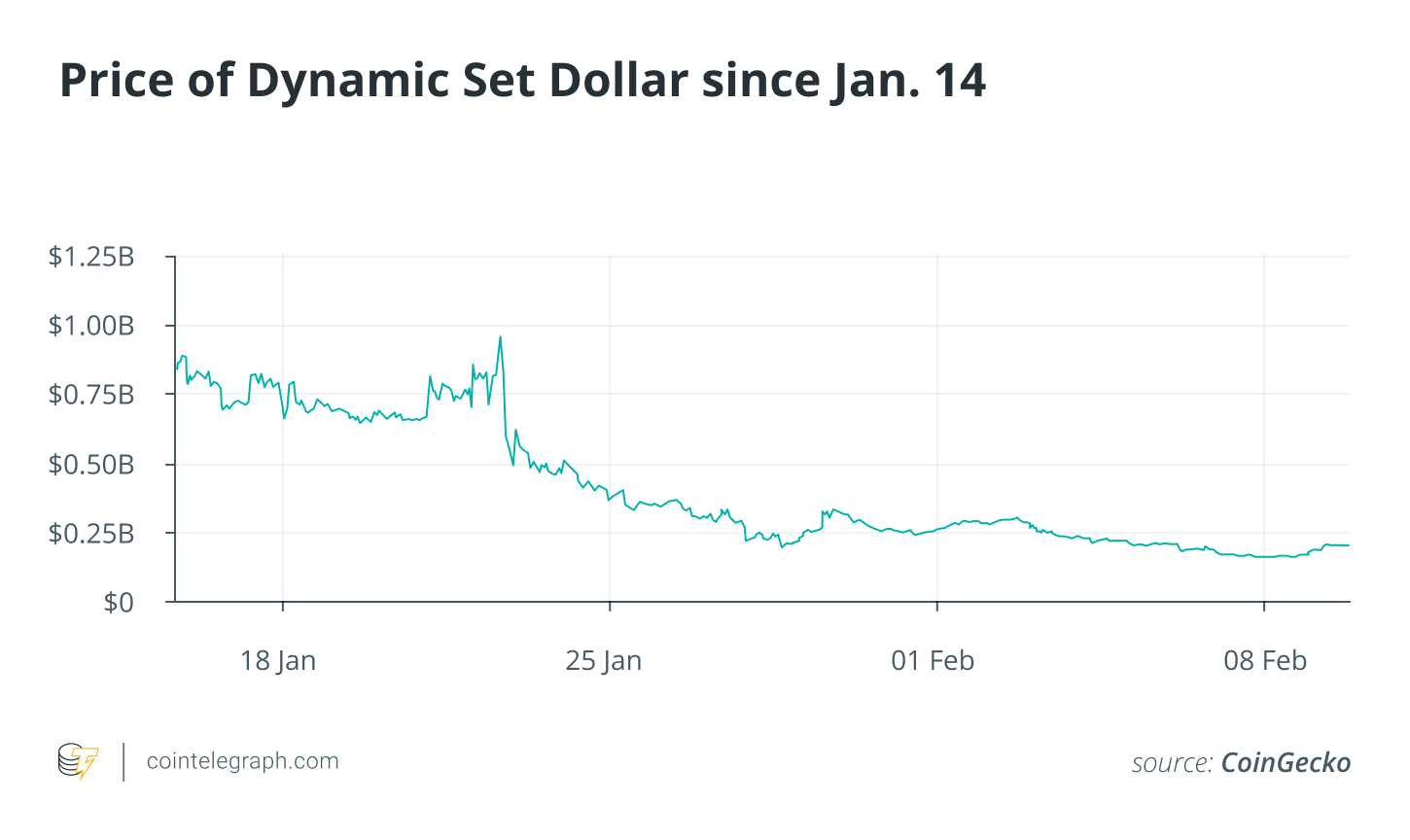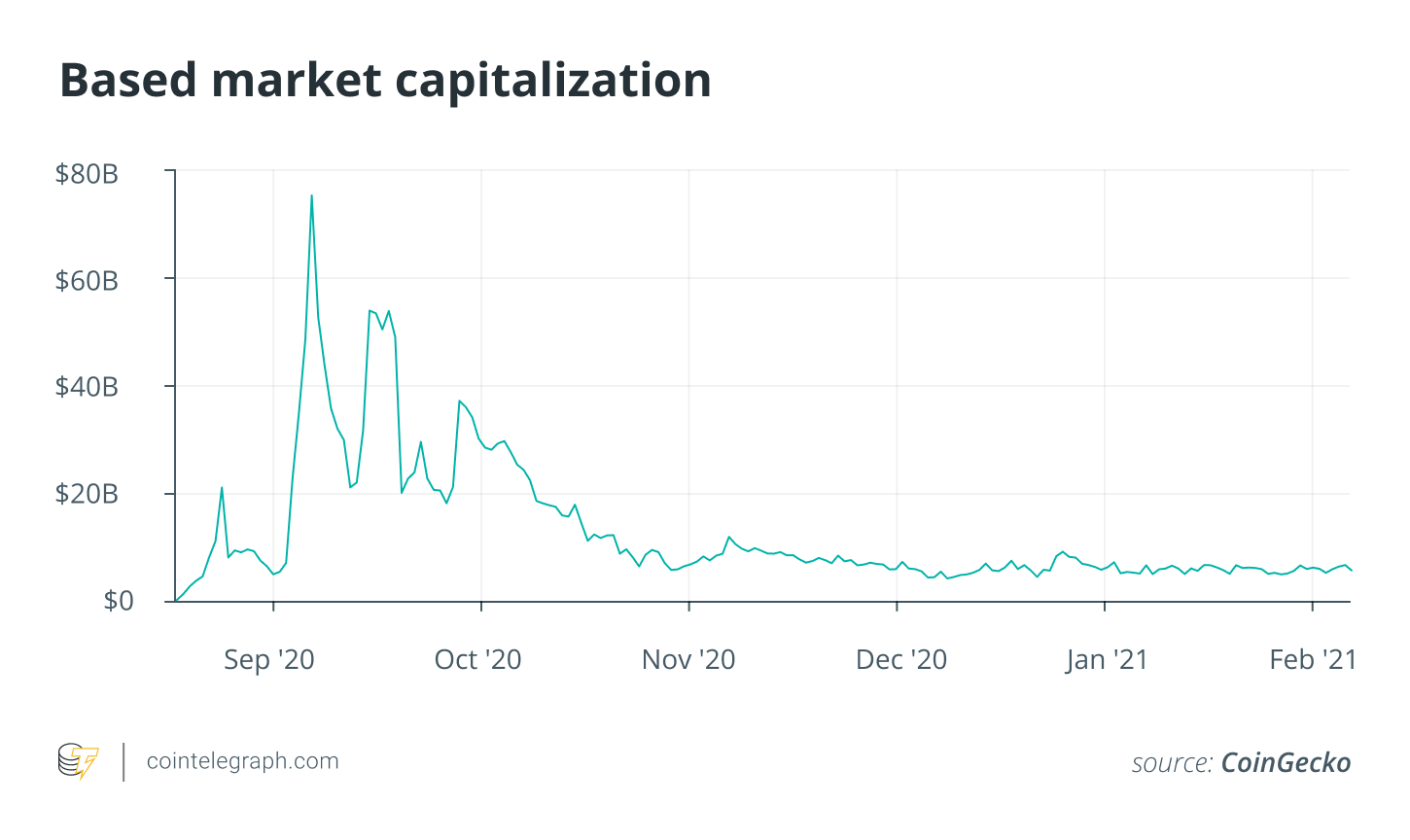Amid the meteoric rise of decentralized finance in 2020, there was persistent interest in a class of coins popularly dubbed “algorithmic stablecoins.” Some of the more famous ones include Ampleforth (AMPL), Based, Empty Set Dollar (ESD) and Dynamic Set Dollar (DSD).
While these tokens are commonly considered algorithmic stablecoins, the teams involved have their own definitions. For MakerDAO, an algorithmic stablecoin is one that uses total supply manipulations to maintain a peg. The founders of Empty Set Dollar and Neutrino, a Waves-backed stablecoin project, believe Dai is also an algorithmic stablecoin due to its programmatic mint-and-burn mechanics. Ampleforth’s team, on the other hand, rejects the notion that its token is a stablecoin.
It is relatively clear that the assets falling under MakerDAO’s definition show little stability. For example, ESD’s all-time high and all-time low are $23.88 and $0.174, respectively, according to CoinGecko. Ampleforth’s reading shows a high of $4.07 and a low of $0.1558. By contrast, Dai’s lifetime trading range has been between $0.90 to $1.22.
In addition to nominal price instability, the supply manipulation tactics used by these tokens further complicate the process of assigning a value. The mechanisms can be grouped into two main categories: rebasing coins and coupon-based mint and burn.
Rebases hold the peg, but at what cost?
The rebase system, used by coins like Ampleforth and Based, is built on periodic expansions and contractions of the entire supply. If the coin is trading above a certain band, about $1.05 for Ampleforth, the supply is expanded at a rate of one-tenth of the price deviation. This means that if the coin is trading for $1.50, then 5% of the total supply will be added each day.
The mechanism does not care about the history of rebases up to that point — if it has already rebased 10 times prior, it will add 5% of the current supply anyway. The process is reversed when the coin trades below $1.
The result is that the token’s supply can grow and shrink at a staggering pace, putting immense pressure on the nominal price. This supply change is distributed evenly between all wallets holding the token, meaning that a user’s total portfolio value does not change if the price shifts exactly by the percentage of new tokens minted.
In practice, the mechanism is quite successful at holding the price around the $1 mark. The exponential growth or reduction of supply eventually overpowers any push too far outside of the designated price. But the fact that every single wallet follows the rebase means that the nominal price is just one small part of the picture.
Gauging whether the coin is actually “stable” requires taking the supply changes into consideration as well, as every wallet is affected by them. When analyzing the total market capitalization to account for both supply and price, it becomes clear that AMPL is extremely volatile.
 Ampleforth’s market cap represents a user’s portfolio fluctuations. Source: CoinGecko.
Ampleforth’s market cap represents a user’s portfolio fluctuations. Source: CoinGecko.
In a conversation with Cointelegraph, Manny Rincon-Cruz, advisor to Ampleforth and co-author of its whitepaper, fully accepted the fact that Ampleforth is unstable:
“Ampleforth holders can experience gains and losses much in the same way that Bitcoin or Ethereum holders can. Thus, it is a speculative investment asset where the probability of gain and the probability of loss are both greater than zero.”
The Ampleforth team has, since its inception, maintained that AMPL is simply a noncorrelated asset to the wider crypto market. A research report by Gauntlet released in July 2020 seems to partially confirm this, as the asset shows no correlation on average. More recent figures offered by Flipside Crypto suggest that correlations can be fleeting — periods of low to negative market cap correlation alternate with periods of very high correlation, which on average should cancel each other out.
 Ampleforth’s correlation parameters can be erratic. Source: Flipside Crypto.
Ampleforth’s correlation parameters can be erratic. Source: Flipside Crypto.
In general, though, Ampleforth’s price dynamics seem to be related to the crypto market fortunes at large. Just like every other asset, its value collapsed in March 2020, while it boomed more or less in unison with the DeFi sector in summer 2020 and early 2021.
Coupon coins struggle to stay at $1
The second major category of algorithmic stablecoins is coupon-based coins. The largest difference from rebasing coins is that holders don’t see their number of tokens change unless they do specific actions. In most mechanisms — for example, as seen in Empty Set Dollar and Dynamic Set Dollar — new tokens are minted when the price is above $1 and are given to special classes of holders who expressed interest in joining governance. A portion of the rewards accrues to Uniswap liquidity providers as well.
In the case of a peg falling below $1, these protocols incentivize holders to burn their algorithmic dollars in exchange for a coupon, or bond. The idea is that with the next supply expansion phase, coupons can be redeemed back for dollars with a premium of up to 56%. Crucially though, for both ESD and DSD, the coupons expire after a period of 30 days.
The coupon-based mechanism simplifies the implementation and practical use of algorithmic stablecoins, as an ESD spokesperson told Cointelegraph:
“Coupons allow for ESD to be seamlessly integrated everywhere ERC-20 is accepted. This is in contrast to rebase tokens which must have case by case integration into all adjoining protocols.”
The downside, however, is that coupon-based coins seem to be much more unstable. One particular episode with DSD at the end of January exemplified the difficulty in maintaining the peg. The DSD community struck a deal with a DSD whale known as “Escobar.eth” to purchase the whale’s stash of 5.5 million DSD.
The whale was reportedly depressing the token’s price, though it is unclear if that was on purpose. The members of the community who accepted the deal, struck at an average price of $0.62 per DSD, had $85 million in coupons set to expire a few days after the purchase.
 DSD holders seem to have capitulated after it failed to reach $1. Source: CoinGecko.
DSD holders seem to have capitulated after it failed to reach $1. Source: CoinGecko.
Unfortunately for the coupon holders, DSD’s price never returned above the crucial $1 mark following the deal. After an initial pump, the price collapsed to its current value of $0.14. While the fall coincided with a wider market correction, the episode showcases the immense risks involved in holding coupons.
It is clear that there are no guarantees that the price will return to $1 within the necessary time frame. The further the divergence from $1, the less likely that becomes, disincentivizing users from creating more coupons. Furthermore, the fact that there is no collateral with a relatively stable value backing the tokens means that the protocol’s value may not recover at all.
A “death spiral” phenomenon can be seen in Based Protocol, which uses the same mechanism as Ampleforth. Since its highs in the “summer of DeFi,” the nominal price has indeed returned to about $1, but the market capitalization remains at depressed levels despite the much stronger bull market at the end of 2020.
 Based market capitalization. Source: CoinGecko.
Based market capitalization. Source: CoinGecko.
What is the purpose of an algorithmic stablecoin?
Given the evident difficulties that algorithmic stablecoins have at maintaining value stability — which should be the defining feature and purpose of a stablecoin — are there other possible benefits to these tokens?
The ESD team said the project’s aim “is to have a decentralised, composable unit of account that can be utilised across DeFi protocols.” They placed the coin in the same category as Dai or USD Coin (USDC), though filling a different niche. “The ability for it to return to peg via an incentive mechanism is its purpose for existing,” they added.
According to Rincon-Cruz, Ampleforth is simply a speculative asset with one major advantage: the ability to denominate contracts that are stable in value. Traditionally, money is considered to have three distinct uses: as a unit of account, medium of exchange and store of value.
A unit of account is how prices are measured. For example, many exchanges and crypto businesses price some of their services in Bitcoin (BTC), meaning that they will receive more value in U.S. dollar terms when BTC is at a higher price.
A medium of exchange is the asset that is actually used for delivering and representing value. Another common practice in the cryptocurrency industry is to negotiate a contract in dollars but pay it in Bitcoin or Ether (ETH) according to the exchange rate at the moment of delivery, making the cryptocurrencies mediums of exchange but not units of account.
Finally, a store of value is an asset that is expected to carry neither losses nor gains over long periods of time, though in practice, this is rarely the case. U.S. dollars lose value over time but are quite stable in the short term, while assets like bonds and gold can have wide swings that still result in long-term growth.
In order for a stablecoin to be useful under all three definitions of money, its value must remain at least somewhat steady. Stable representations of the dollar, such as USD Coin and Dai, are good at all three characteristics of money. Major cryptocurrencies like Bitcoin and Ether have been historically used in all three functions, though the rise of stablecoins has diminished their use in business transactions.
Related: DeFi-ing expectations: Great opportunities in crypto can come at a price
A currency like Ampleforth can be somewhat useful as a unit of account but so far shows excessive volatility for the other two uses. Coupon-based coins appear to be far too volatile to be used as money in any scenario.
In practice, algorithmic stablecoins that use supply manipulation have seen virtually no adoption in any environment where U.S. dollars may be used, even as a unit of account. The Ampleforth team is currently working to integrate its coin in the Aave lending protocol, which would be the first lending integration for the project since it was launched in 2018. ESD is available on the Cream lending platform, though there are virtually no borrowers.
Can a better algorithm make value stability a reality?
The ESD team believes that the perfect mechanism hasn’t been found yet because “getting an algo stablecoin to work is almost an intractable problem to solve on the first try.” Reaching value stability is a question of incentives and adoption, according to the ESD spokesperson:
“To reach stability the roadmap is speculation, then liquidity, and then stability. How do you get stability? With liquidity. But how do you get liquidity? With speculation. At each point we’ll need to adjust the protocol via governance to pull us closer and closer to the goal but by no means will we nail it in one go.”
The team behind ESD believes reflexivity will eventually make the token effectively stable. In a nutshell, reflexivity is a self-fulfilling belief — market participants expect the asset to behave in a certain way, and their actions make that prediction come true.
Rincon-Cruz, on the other hand, believes that a “perfect mechanism” does not exist, adding that, “The trifecta of adaptive supply, durable value (in holdings), and a stable peg […] is impossible.” He went on: “Even with [pegged] national currencies, these three functions are impossible to fulfill, unless a society has decided to pay a considerable cost.”
A potential counterexample is offered by Neutrino USD (USDN), a hybrid stablecoin using both a collateral pool to back its value and a coupon-based algorithm. The latter is used when the system becomes undercollateralized, with a price algorithm providing significant rewards for backstopping the loss.
The coin has had much milder fluctuations than both ESD and DSD, from a low of $0.79 on March 13, 2020 to a maximum of $1.06 on Jan. 29, and it generally holds a $1 price. Its supply is elastic and depends on the market’s demand for the stablecoin, as it can be minted and redeemed freely with Waves tokens. This is in contrast with MakerDAO, where the maximum amount of Dai in circulation is defined by governance and depends on the popularity of the lending protocol.
“Neutrino design was inspired by the idea to combine purely market mechanisms with using the value of native blockchain tokens, and translating the underlying blockchain economy into a stable assets economy,” Sasha Ivanov, founder of Waves, told Cointelegraph.
The recently released Arth token by MahaDAO also attempts to offer a new spin on the concept of algorithmic stablecoins. Its bond-based mechanism acts directly on the price of the stablecoin through a direct integration with Uniswap pools. A spokesperson explained the design rationale of the system to Cointelegraph:
“Controlling the supply is a very weak way to influence the price. With ARTH, we are integrating the protocol directly with Uniswap. Which means that traders participating in the algo coin have a much stronger impact on the price, than with other algo coins.”
Bonds are purchased for Dai that is sent to a Uniswap pool. This directly influences the token’s price during the burn process, and so far, the token appears to have avoided the excessive deviation from $1 seen in other non-rebasing coins. Amid a market capitalization drop of about 50% since Jan. 26, its price only fell about 20%, from $0.86 to $0.69, according to CoinGecko.
Perhaps newer mechanisms and market dynamics may lead to an algorithmic stablecoin that holds its value effectively. Still, all existing stablecoin designs have yet to convincingly prove that they can work. Following the March 2020 crash, Dai increasingly began to rely on USDC to facilitate its peg, which some argue runs counter to its purpose.
While the market appears to be satisfied by Dai’s features, there could still be space for an upstart stablecoin that fixes all potential flaws with existing implementations without sacrificing decentralization.





